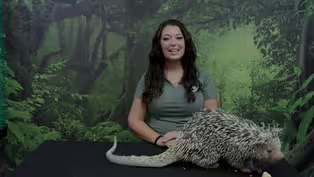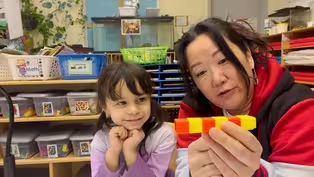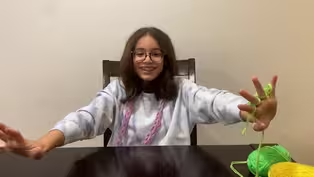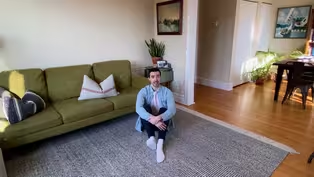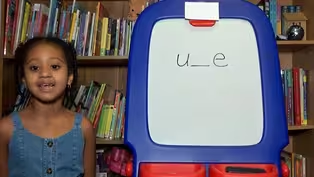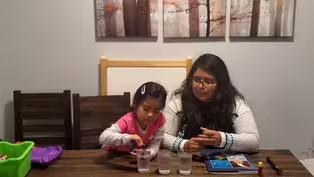
MUSICAL LIGHT GAME
Clip: 5/5/2023 | 9m 43sVideo has Audio Description, Closed Captions
David Martinez prompts viewers to sing loudly and softly using colored lights.
David Martinez from Education Through Music sings a welcome song in Portuguese. Introducing the musical terms piano and forte, he prompts viewers to sing loudly and softly using colored lights.
See all videos with Audio DescriptionADProblems playing video? | Closed Captioning Feedback
Problems playing video? | Closed Captioning Feedback
Let's Learn is a local public television program presented by THIRTEEN PBS

MUSICAL LIGHT GAME
Clip: 5/5/2023 | 9m 43sVideo has Audio Description, Closed Captions
David Martinez from Education Through Music sings a welcome song in Portuguese. Introducing the musical terms piano and forte, he prompts viewers to sing loudly and softly using colored lights.
See all videos with Audio DescriptionADProblems playing video? | Closed Captioning Feedback
How to Watch Let's Learn
Let's Learn is available to stream on pbs.org and the free PBS App, available on iPhone, Apple TV, Android TV, Android smartphones, Amazon Fire TV, Amazon Fire Tablet, Roku, Samsung Smart TV, and Vizio.
Providing Support for PBS.org
Learn Moreabout PBS online sponsorship[upbeat music] [upbeat bluesy music] ♪ Hello friends ♪ Hello friends ♪ Hello friends ♪ It's time to say hello - Hello everybody, welcome to this music time.
This is Mr. Martinez.
I am so happy you are here.
Today, I have a new instrument.
This is an electric guitar.
Yes, it is called electric because it needs an amplifier, this guy over here, to get the sound out of the instrument.
If I close the volume, this is the sound that we get.
[soft bluesy music] Oh, it's not too loud.
When I turn it up, check it out.
[loud bluesy music] And it has six strings, like acoustic guitar.
And that's why it is electric guitar.
And it is time to say hello, everybody!
♪ Hello friends ♪ Hello friends ♪ Hello friends ♪ It's time to say hello If you have the chance to go to Portugal or to go to Brazil, you'll need to learn a special way to say hello.
Actually, you say, good morning.
You say, bom dia.
Everybody with me, bom dia.
And let's try to it say singing.
[David singing "Hello Friends" in Portuguese] ♪ It's time to say hello - And again!
[David singing "Hello Friends" in Portuguese] ♪ It's time to say hello - Yay, I'm so happy you are here.
And today we're going to learn a little bit about music.
Actually, we are gonna learn two special words that we use in music to describe how loud or quiet the sound is.
But before we get those two words we are going to learn today, I want to sing with you a special song.
It is called, "Ding Dong Diggidiggidong".
It's super easy, say it with me.
Ding, Dong, Diggidiggidong.
Ding, dong.
Diggi-diggi-dong, the cat, she's gone!
Ding, dong, diggi-diggi, dong.
Diggi-diggi-dong, ding, dong.
Wow, that was great.
Now, we are going to put everything together and we will have a wonderful song.
I sing first, then you sing, you ready?
♪ Ding dong diggi-diggi-dong ♪ Diggi-diggi-dong the cat she's gone ♪ ♪ Ding dong diggi-diggi-dong ♪ Diggi-diggi-dong ding dong - Oh, let's use the guitar to see how it sounds all together.
It's not that hard.
It's easy for you, smart people.
One, two, everybody sing it.
♪ Ding dong diggi-diggi-dong ♪ Diggi-diggi-dong the cat she's gone ♪ ♪ Ding dong diggi-diggi-dong ♪ Diggi-diggi-dong ding dong - One and two and try it again.
♪ Ding dong diggi-diggi-dong ♪ Diggi-diggi-dong the cat she's gone ♪ ♪ Ding dong diggi-diggi-dong ♪ Diggi-diggi-dong ding dong - Yes, but what about if we sing a little bit louder?
One and two, and everybody goes.
♪ Ding dong diggi-diggi-dong ♪ Diggi-diggi-dong the cat she's gone ♪ ♪ Ding dong diggi-diggi-dong ♪ Diggi-diggi-dong ding dong - Now, we're gonna volume it down.
Boop!
So are you gonna find my button on my ear?
Beep!
Okay, now it's time to sing it quietly.
One and two and here we go.
♪ Ding dong diggi-diggi-dong ♪ Diggi-diggi-dong the cat she's gone ♪ ♪ Ding dong diggi-diggi-dong ♪ Diggi-diggi-dong ding dong - I hope you are ready for the challenge that we have today.
Okay, ready?
In today's challenge, we're going to follow the light color.
What do you mean, Mr. Martinez?
I have a blue light right here.
Let me turn it on, ready?
And when you see this blue light, you are going to sing really quiet.
♪ Ding dong diggi-diggi-dong ♪ Diggi-diggi-dong the cat she's gone ♪ ♪ Ding dong diggi-diggi-dong ♪ Diggi-diggi-dong ding dong - But I have also this wonderful red color.
If you see this red color, it is time to sing really loud.
Just remember, singing is singing, it's not yelling.
You sing, nice, beautiful, but loud.
One and two and try with me.
♪ Ding dong diggi-diggi-dong ♪ Diggi-diggi-dong the cat she's gone ♪ ♪ Ding dong diggi-diggi-dong ♪ Diggi-diggi-dong ding dong - I hope you're ready.
And let's start, we're gonna sing loud or quiet.
Blue or red?
Let's try it, one and two and here we go.
♪ Ding dong diggi-diggi-dong ♪ Diggi-diggi-dong the cat she's gone ♪ ♪ Ding dong diggi-diggi-dong ♪ Diggi-diggi-dong ding dong - Wow, that was awesome!
How it was, you saw how you changed the volume?
That was amazing.
When we have the blue color, in Italian, there is an Italian word that we use for music.
That word is piano.
Piano means sing or play quietly.
And we have another Italian word for this sound that is loud.
It is forte.
Say it with me.
Forte.
Piano.
Forte.
Forte.
So I have you're ready and I will show you how loud you should be singing.
One and two and here we go.
♪ Ding dong diggi-diggi-dong ♪ Diggi-diggi-dong the cat she's gone ♪ ♪ Ding dong diggi-diggi-dong ♪ Diggi-diggi-dong ding dong - But this time, I'm not going to help you, okay?
It's up to you to follow how loud, piano or forte, you need to sing.
Are you ready?
One and two and sing with me.
♪ The cat she's ♪ Ding dong diggi-diggi-dong ♪ Ding dong diggi-diggi-dong ♪ Ding - Woo, that was amazing!
Children, just remember the sound could be really quiet or really loud.
Have you heard something loud, loud, loud in your neighborhood?
Of course.
I think when the ambulance is passing, that is too loud.
[David makes ambulance siren sound] Have you heard something really quiet?
Maybe some birds in the morning?
[David whistles softly] What else is really, really, really, really quiet?
Tell me.
We are surrounded by wonderful sounds.
Some of them are really loud, some of them are really quiet.
My friends, it's time to say goodbye.
What about we invite our friend out today, the electric guitar to say goodbye.
Are you ready?
Here we go.
♪ Goodbye friends ♪ Goodbye friends ♪ Goodbye friends ♪ It's time to say goodbye - Goodbye, see you next time!
Video has Audio Description, Closed Captions
Clip: 5/5/2023 | 8m 59s | Devon Ritter from the Memphis Zoo explores the relationship animals have to light. (8m 59s)
Video has Audio Description, Closed Captions
Clip: 5/5/2023 | 5m 57s | Zoe Kleinmann and a student make a pattern of light with translucent cups. (5m 57s)
DAHLIA SHOWS HOW TO FINGER KNIT!
Video has Audio Description, Closed Captions
Clip: 5/5/2023 | 1m 19s | Dahlia shows how to finger knit. (1m 19s)
Video has Audio Description, Closed Captions
Clip: 5/5/2023 | 10m 56s | Aaron Umsted prompts children to tap their feet up and down like a light switch. (10m 56s)
Video has Audio Description, Closed Captions
Clip: 5/5/2023 | 8m 18s | Anna Scretching-Cole explores the long u vowel sound. (8m 18s)
Video has Audio Description, Closed Captions
Clip: 5/5/2023 | 11m 8s | With her daughter Katherine Rodriguez reads A RAY OF LIGHT by Walter Wick. (11m 8s)
Providing Support for PBS.org
Learn Moreabout PBS online sponsorshipSupport for PBS provided by:
Let's Learn is a local public television program presented by THIRTEEN PBS
